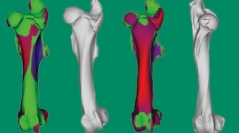

 Comptes Rendus Palevol
21 (9) - Pages 191-205
Comptes Rendus Palevol
21 (9) - Pages 191-205In this study, we suggest a method adapted to the retrodeformation of asymmetrical objects – such as limb bones – by quantitatively estimating the effectiveness of the Thin-Plate Splines (TPS) interpolation function as a retrodeformation tool. To do so, taphonomic deformations were first simulated on a single horse femur. The original bone was then used as a reference in order to drive the retrodeformation using anatomical landmarks. This approach, based on a single bone, enabled us to evaluate the performance of the retrodeformation procedure. Then, the same approach was performed on a sample of rhino femora but using a different specimen (from the same species) as the reference in order to account for morphological variation. We also added sliding semi-landmarks on anatomical curves. Finally, retrodeformation was applied on a sample of sauropodomorph dinosaur femora by building a mean shape based on several well-preserved fossil specimens. Results show that entirely flattened and stretched bones are more efficiently retrodeformed than bent and twisted bones. Introduction of morphological variation increased the efficiency of retrodeformation for bent and locally stretched bones. The application to the sample of fossils produced similar results but also highlighted the difficulty of retrodeforming bones with a combination of different deformations. TPS interpolation is an efficient tool of retrodeformation for asymmetrical objects, especially for bones with only one affine deformation such as flattening or stretching. Finding a threshold of landmark number to use for this process would be the next step because it would allow us to ensure the quality of retrodeformation while keeping available a reasonable number of landmarks in order to perform shape analysis on retrodeformed bones. Twisted and bent fossils are frequently discovered and we suggest that these kinds of deformations should be studied with caution, especially when combined with other types of taphonomic distortions.
Plateosauridae, Rhinocerotoidae, Equidae, Retrodeformation, taphonomy, 3D geometric, morphometrics, limb bones